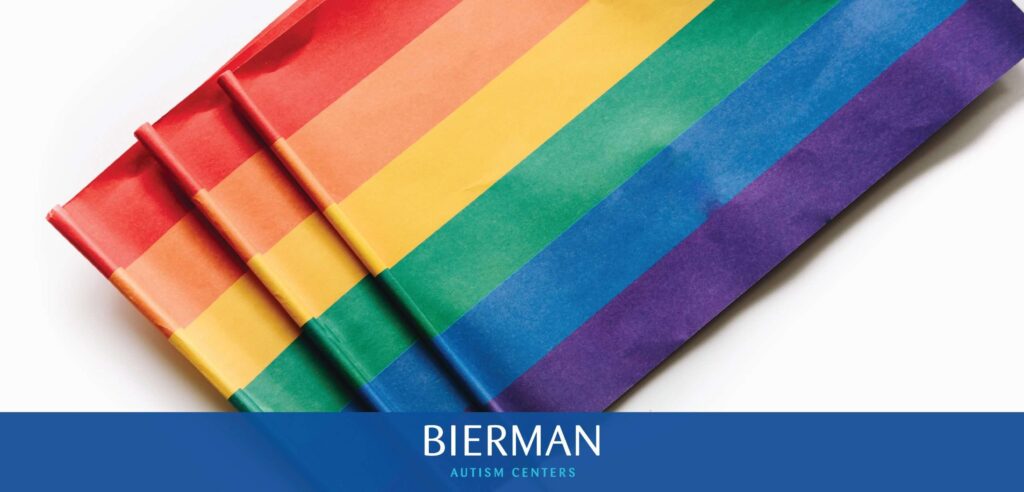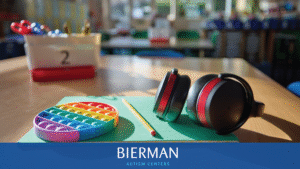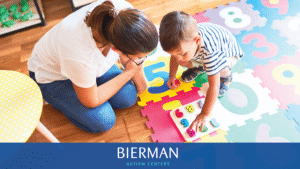This Pride Month, clinical team member Emily Gronlund shares what Bierman Autism Centers is doing to be an ally and how you can help.
At Bierman Autism Centers, one of our Core Values is to “Continuously Raise the Bar.” This value is carried through all aspects of the company, from our 1:1 therapy to supporting fellow staff members to creating a fun and stimulating work environment. This Pride month, we are raising the bar by spreading awareness about the history of Pride month, showing up for the community, and learning more about LGBTQIA+ identities, organizations, and representation in media. These actions are great ways to be an ally both within and for the LGBTQIA+ community. But allyship doesn’t stop at Pride month. We challenge all ABA professionals to consider diverse identities in their services and support LGBTQIA+ families, clients, and staff members all year long. Here’s how!
1. Create a Safe Space for LGBTQIA+ Individuals: Whether it’s a staff member, client, or stakeholder, strive to create a comfortable environment for those who identify as LGBTQIA+. One way Bierman does this is by providing a space in all staff’s email template to share their pronouns if they feel comfortable. Other ideas include:
-
- Provide forms that allow individuals to specify their gender expression beyond the binary of male and female. Don’t require people to specify titles such as Mr. Ms. and Mrs.
- Should you encounter individuals in your professional environment who identify differently than you do, take time to educate yourself on their identity. Don’t rely on them to educate you.
- Be open-minded! You can never assume how someone identifies simply based on how they look.
- If you make a mistake, treat it as a learning opportunity. We challenge our clients and staff to make every moment a learning opportunity. This applies when supporting the identity of others as well.
2. Provide materials for clients that represent a diverse range of identities!
-
- In ABA, we teach our clients a wide variety of social skills, often using pictures and stories that include images of other people. When we are teaching social concepts, it’s important that we teach these concepts across a wide variety of people. ABA serves a diverse population of clients and stakeholders. This should be represented in the materials and programming that we provide to our clients.
- Diverse representation in programming include, but are not limited to:
-
-
- Ages ranging from infants to older adults -> Our kids won’t stay kids. They also won’t only ever encounter young adults or only ever encounter other kiddos
- Non-binary gender expressions
- Blended families and families that are non-heteronormative
- Disabled people -> ABA professionals often work with a disabled population. It is imperative that our materials reflect our clientele
- Racial diversity
- Representing populations such as the ones described above may include purchasing books and materials that represent a wide variety of people. Additionally, when making materials, ABA professionals should consider the faces and bodies that they are including in their materials. We challenge them to ask themselves if the materials they are making represent a wide variety of identities and especially whether those materials reflect the identity of their client.
-
3. Use inclusive language!
-
- We are often socialized to use gendered and heteronormative language in our everyday life. Here are some simple swaps that are inclusive for everyone and appear often in ABA:
- Community Helpers: Mail carrier/postal worker, server, firefighter, and flight attendant
- Family Members: Parent, grown-up, adult, sibling
- People: Folks, everybody, people, person
- Pronouns: They referring to a singular person
- Relationships: Partner, significant other
- Forms of Address: friend, pal, amigae, mate
The bottom line: In ABA we often teach clients important and necessary aspects of living in the world. Therefore, our materials, programming, setting, and language should depict the world as it is: Diverse.
We hope the points listed above serve as a jumping off point for ABA professionals when considering representation within ABA. See these two blog posts from The Sexual Behavior Research and Practice Special Interest Group of ABAI and Children’s National Hospital for further discussions:
- https://sbrpsig.wordpress.com/2017/08/26/the-importance-of-creating-a-safe-space-for-your-lgbtq-disabled-clients/
- https://sbrpsig.wordpress.com/2017/08/26/the-importance-of-creating-a-safe-space-for-your-lgbtq-disabled-clients/
- https://childrensnational.org/departments/gender-development-program/gender-and-autism-program


